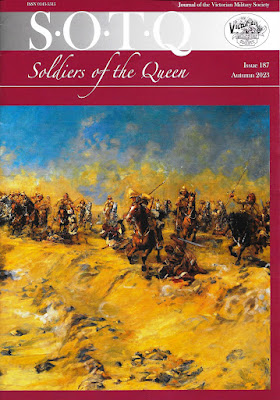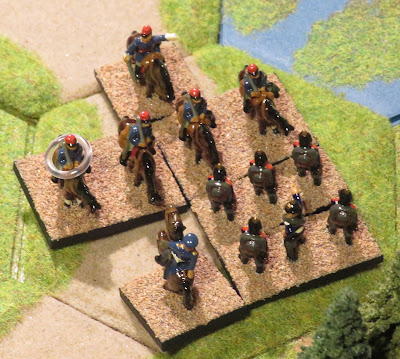The background to the conflict
Over the past few months there had been rumours that both Redina and Bluvia had been building defences in the demilitarised zone that stretched along the boundary between the two countries. These were unconfirmed, but tension between the two long-term enemies had been growing and the newspapers were full of stories about both countries surreptitiously mobilising their armies. It looked as war was inevitable ... and that the merest spark could easily ignite the tinderbox!
That spark was provided by a Redinan shepherd whose sheep were grazing in a field near to the river. He saw several riders on the Bluvian side of the river who appeared to be in some sort of uniform, and he reported this to the local constable when he returned to his home in Redville. The constable immediately telephoned his superior in Redton to report what the shepherd had seen, and as soon as he had heard this, the chief constable sent a messenger to the Minister of War. The Minister contacted the Prime Minister, and after an emergency Cabinet meeting, the Redinan Army was mobilised.
What the shepherd had seen was members of the Blueford Hunt scouring the countryside for some unfortunate fox the chase. However, once news of the Redinan mobilisation reached the ears of the Bluvian government, they responded by mobilising their own army. The question now was who would start the hostilities.
The mobilised Redinan Army. Click on the image to enlarge it.
The mobilised Bluvian Army. Click on the image to enlarge it.
Day 1: Morning
Redina moved first. Their forces surged forward and seized all three bridges over the river that was the boundary between the two countries.
In response, the Bluvian's moved their machine gun unit forward from Blueburg ...
... whilst their general moved the infantry unit (and himself) forward from the country in front of Blue City and onto the road.
This ensured that the Bluvian artillery in Blue City could fire at the Redinan column that was advancing over the middle river bridge.
The Bluvian machine gun unit inflicted two casualties on the Redinan infantry crossing the bridge between Red City and Blueburg ...
... whilst the Bluvian artillery in Blue City and Blueford both scored telling hits on the Redinan columns that were moving across the other bridges.
In the case of the central Redinan column, this also meant that the Redinan general stood a chance of being hit ... but he wasn't.
At this point, the Redinan's had lost 4 SPs and the Bluvian's had lost none.
Day 1: Midday
The Redinans continued to advance into Bluvian territory along all three roads, ...
... which resulted in several clashes.
The Bluvians countered by moving their unengaged troops forward to meet the invaders.
(It was now time for the machine gun and artillery fire phases. I decided that as these tale place before any close combat is due to occur, I would allow machine guns and artillery to fire as normal even though they might be about to take part in close combat.
The Bluvian machine gun unit fire at the Redinan infantry in the adjacent hex ...
... and inflicted the lose of 1 SP. In the centre of the battlefield, the Bluvian artillery fired at the Redinan Artillery that was moving along the Redville-Blueford road ... and wiped it out! The Redinan artillery was able to fire back before it was destroyed, but its fire was ineffective. The Bluvian artillery in Blueford was able to fire at the oncoming Redinan infantry, and cause the los of 1 SP.
Across the entire frontline, intense close combat took place.
Around Blueford, the close combat resulted in the Redinan infantry suffering further casualties and losing the close combat.
In the centre, the Redinan cavalry inflicted the los of 1 SP on the Bluvian infantry, but the Bluvian general managed to avoid any injury.
Near Blueburg, the already depleted Redinan infantry was repulsed by the Bluvian troops facing them, having suffered further casualties.
At this point, the Redinans had lost 11 SPs and the Bluvians had lost 2 SPs.
Day 1: Afternoon
Despite the high level of casualties already suffered, the Redinans continued to push forward wherever the could. They threw their remaining infantry unit and their machine gun unit into the fighting around Blueford.
This was countered by the Bluvian cavalry, which charged them in the flank.
However, before any close combat could be resolved, both sides machine guns and artillery had the opportunity to fire.
On the outskirts of Blueford, the Redinan machine gun unit's fire wiped out the Bluvian artillery unit ...
... but it and its supporting infantry suffered casualties from artillery fire from the Bluvian artillery near Blue City.
Just outside Blueburg, the Bluvian machine gun unit inflicted the loss of 2 SPs on the Redinan infantry that was facing them, which resulted in the Redinan unit's destruction.
At this point (and before any close combats could take place), the Redinans had lost 15 SPs and the Bluvians had lost 3 SPs. The Redinans had therefore reached their Exhaustion Point but could carry on fighting until the evening.
The Bluvian cavalry charge resulted in both sides losing 1 SP ...
... and in the centre, the fighting between the Redinan cavalry and Bluvian infantry likewise resulted in both sides losing 1 SP.
At this point, the Redinans had lost 17 SPs and the Bluvians had lost 4 SPs.
Day 1: Evening
During the evening, the Redinans withdrew, and the Bluvians moved forward to secure their frontier.
Day 1: Night
During the night the Redinan Army returned to its barracks and the Bluvians occupied positions along the river between the two countries. The Redinans were able to recover 2 SPs and the Bluvians recovered 1 SP, but the Redinans were still too weak to resume hostilities and the Bluvians saw no reason to invade the territory of their defeated foe. The 'One Day War' as it became known, was over.
Some afterthoughts
The rules worked quite well and I had a great deal of fun play-testing them. They still require a bit of finetuning, but in essence I am happy with the way they work.
The results of both the firing and the close combat may appear to have been a bit one-sided, but I was scrupulous when it came to what tactical decisions I made during this solo wargame, and to make sure that there was no bias in my dice rolling, I used red and blue dice and a dice tower to ensure that there were no cocked dice or any opportunity for me to influence the results.
Finally, and from a personal point-of-view probably most importantly, I had a great deal of fun and enjoyed fighting this solo wargame for several reasons.
Firstly, because it is the first time since I began having my radiotherapy in late August that I have had the inclination and motivation to set up and fight a wargame.
Secondly, for various personal reasons I have not had the opportunity to stage a wargame in my toy/wargames room since the beginning of May ... a gap of six months!
Thirdly, this is the first time these figures have faced each other in battle since they were painted nearly forty years ago!



























































.jpg)


















.jpg)

.jpg)







